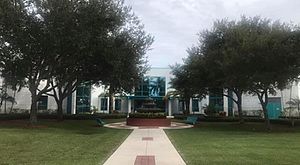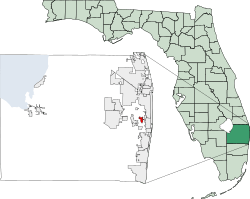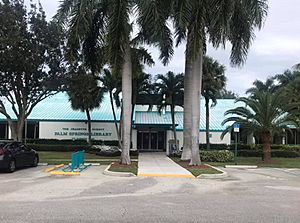Palm Springs, Florida facts for kids
Quick facts for kids
Palm Springs, Florida
|
|
|---|---|
| Village of Palm Springs | |

Palm Springs Village Hall
|
|
| Motto(s):
"Garden Spot of Palm Beach County"
|
|

Location of Palm Springs, Florida
|
|
| Country | |
| State | |
| County | |
| Incorporated | May 31, 1957 |
| Government | |
| • Type | Council-Manager |
| Area | |
| • Total | 4.25 sq mi (11.02 km2) |
| • Land | 4.21 sq mi (10.90 km2) |
| • Water | 0.05 sq mi (0.12 km2) |
| Elevation | 10 ft (3 m) |
| Population
(2020)
|
|
| • Total | 26,890 |
| • Density | 6,391.73/sq mi (2,467.75/km2) |
| Time zone | UTC−05:00 (Eastern (EST)) |
| • Summer (DST) | UTC−04:00 (EDT) |
| ZIP Codes |
33406, 33415, 33461
|
| Area code(s) | 561, 728 |
| FIPS code | 12-54450 |
| GNIS feature ID | 0293892 |
Palm Springs is a village in Palm Beach County, Florida, United States. It is about 61 miles (98 km) north of Miami. The village's name might come from the resort city of Palm Springs, California.
Palm Springs is located in the east-central part of Palm Beach County. It is near cities like Atlantis, Greenacres, Lake Clarke Shores, Lake Worth Beach, and West Palm Beach. In 2020, about 26,890 people lived here. Palm Springs is also part of the larger Miami metropolitan area.
The village started as a dairy farm in 1927, run by William A. Boutwell. It grew to about 700 acres before he retired in 1956. Palm Springs officially became a village on May 31, 1957. At first, it was just farmland with no permanent residents. But within two years, about 800 homes were built. Four schools were also built in or near Palm Springs between 1959 and 1970.
Since 1998, Palm Springs has been growing by adding nearby areas. This has more than doubled its size and population. By 2010, most of the people living in Palm Springs were of Hispanic or Latino background. The village is also home to the Fulton-Holland Educational Services Center, which is the main office for the School District of Palm Beach County.
Contents
History of Palm Springs
How the Village Began
In 1927, William A. Boutwell started a dairy farm in the area that is now Palm Springs. He had moved to Florida from Massachusetts. His farm grew to cover about 700 acres. At its busiest, the Boutwell Dairy had over 1,000 Guernsey cattle. It became one of the biggest dairy farms in Florida. William A. Boutwell also invented half-and-half creamer. He retired in 1956, and his family sold the farm by 1965.
In 1957, a group called Moore Associates Development Group planned to build a new community on the former dairy farm land. This area was about 700 acres and only had one building, a large dairy barn. A law was passed to create the village of Palm Springs. It officially became a village on May 31, 1957. The village was likely named after the city of Palm Springs, California. James E. Moore, who founded Moore Associates, became the first mayor of Palm Springs.
Early Growth and Development
To prepare the land for building, workers moved tons of soil to improve drainage and make the area look nice. They also built a water and sewage system. By August 1958, about 800 homes were already built. Because the population grew so fast, four schools were built in or near Palm Springs between 1959 and 1970. The first, Palm Springs Elementary School, opened in September 1959.
For the first few years, the village government worked out of the old dairy barn. This barn was later used as a church. In February 1960, a new village hall opened. The first official count of people in 1960 showed that 2,503 people lived in Palm Springs. By 1962, the village had 38 paved roads.
Modern Expansion and Changes
The number of people in Palm Springs grew a lot in the 1970s. It almost doubled from 4,340 people in 1970 to 8,166 in 1980. The Jeanette J. Guerty Palm Springs Library opened on November 11, 1978. It was later made bigger in the mid-1980s.
For about 40 years, the village's borders stayed mostly the same. But in 1997, the village council decided to expand Palm Springs. This plan aimed to add about 10,000 more residents. In the late 1990s, plans also began to update the village's main buildings.
A new, larger village hall opened in July 2003. The expanded library and a new public safety building opened in 2004 and 2005. In 2005, Hurricane Wilma damaged many homes in Palm Springs, more than in any other town in Palm Beach County. In 2007, Palm Springs celebrated its 50th anniversary. By 2010, most residents in the village identified as Hispanic or Latino.
The Lakewood apartment community, with 96 units, was built using special Lego-style blocks. These blocks are made from recycled glass, plastic, resins, and limestone.
Geography of Palm Springs
Palm Springs is located in east-central Palm Beach County. It is next to cities like Greenacres, Lake Clarke Shores, Lake Worth Beach, and West Palm Beach. Since 1998, Palm Springs has been growing by adding more land.
In 2020, the village covered about 4.25 square miles (11.02 square kilometers). Most of this area is land, with a small part being water. The original village area has a series of artificial lakes connected by canals. These were built in 1957 to help with drainage.
Palm Springs is in an area where the ground is mostly made of coquina, sand, and sandy limestone. The average height of Palm Springs above sea level is about 10 feet (3 meters).
Climate in Palm Springs
Palm Springs has a tropical climate. This is similar to the weather found in many parts of the Caribbean. It is one of the few places in the United States that has this type of climate. It mostly has a tropical rainforest climate, which means it's warm and rainy year-round.
Population and People
| Historical population | |||
|---|---|---|---|
| Census | Pop. | %± | |
| 1960 | 2,503 | — | |
| 1970 | 4,340 | 73.4% | |
| 1980 | 8,166 | 88.2% | |
| 1990 | 9,763 | 19.6% | |
| 2000 | 11,699 | 19.8% | |
| 2010 | 18,928 | 61.8% | |
| 2020 | 26,890 | 42.1% | |
| U.S. Decennial Census | |||
Who Lives in Palm Springs?
| Race | Pop 2010 | Pop 2020 | % 2010 | % 2020 |
|---|---|---|---|---|
| White (NH) | 6,698 | 5,916 | 35.39% | 22.00% |
| Black or African American (NH) | 1,987 | 3,567 | 10.50% | 13.27% |
| Native American or Alaska Native (NH) | 23 | 43 | 0.12% | 0.16% |
| Asian (NH) | 314 | 461 | 1.66% | 1.71% |
| Pacific Islander or Native Hawaiian (NH) | 4 | 16 | 0.02% | 0.06% |
| Some other race (NH) | 42 | 165 | 0.22% | 0.61% |
| Two or more races/Multiracial (NH) | 275 | 523 | 1.45% | 1.94% |
| Hispanic or Latino (any race) | 9,585 | 16,199 | 50.64% | 60.24% |
| Total | 18,928 | 26,890 |
In 2020, there were 26,890 people living in Palm Springs. There were 8,066 households and 5,664 families.
Between 2010 and 2020, Palm Springs grew faster than any other town in Palm Beach County. Its population increased by about 42%. The census also showed that Palm Springs is the only town in the county where most residents are of Hispanic background.
In 2010, about 23.7% of the people were under 18 years old. About 12.7% were 65 or older. The average age was 36.2 years. For every 100 males, there were about 107 females.
Economy and Jobs
In 2020, Palm Springs had about 12,225 people working. Most residents (55.1%) worked within 10 miles (16 km) of their homes. However, only 8.5% of residents worked in Palm Springs itself. Many people from Palm Springs work in nearby cities like West Palm Beach, Boynton Beach, and Lake Worth Beach.
The biggest employers in Palm Springs are Oxygen Development, a company that makes cosmetics, and the Fulton Holland Educational Services Center. The Fulton Holland Educational Services Center is the main office for the School District of Palm Beach County. The largest job areas in Palm Springs are construction, healthcare, and retail.
To help the economy grow, the Palm Springs Community Redevelopment Agency (CRA) has plans for two business areas. One area, the Congress Avenue Subdistrict, includes larger businesses like a trampoline park, the school district headquarters, a car dealership, and a YMCA. The other area, the Lake Worth Road Subdistrict, has businesses like a Home Depot and a swap shop. There are also other shopping centers in the village, including the Palm Springs Shopping Center and Greenwood Shopping Center, which has a Publix grocery store.
Education in Palm Springs
Palm Springs is part of the School District of Palm Beach County. The district's main office, the Fulton-Holland Educational Services Center, is located in Palm Springs.
Schools in the Village
Three public schools are located within Palm Springs:
- Palm Springs Elementary School
- Palm Springs Community Middle School (formerly Jefferson Davis Junior High School)
- Clifford O. Taylor/Kirklane Elementary
Several other schools in nearby areas also serve students from Palm Springs. For high school, students living north of the L-8 canal or east of Congress Avenue go to Forest Hill Community High School. All other high school students go to John I. Leonard Community High School.
There is also a private religious school, St. Luke's Catholic School, in Palm Springs. The village has a charter high school called Palm Beach Preparatory Charter Academy. The G-Star School of the Arts, another public charter high school, is just outside the village.
Colleges and Universities
There are no colleges or universities directly in Palm Springs. However, the main campus of Palm Beach State College is very close by in unincorporated Lake Worth Beach. Other higher education schools, like Keiser University and Palm Beach Atlantic University, are in West Palm Beach.
Palm Springs Public Library
The Palm Springs Public Library is located in the village government complex. As of November 2021, the library has over 91,000 items, including more than 48,000 books.
The library started in the 1960s with donated books. These books were kept in a room in the old village hall. When the collection grew too big, the books were moved to a larger trailer. In the early 1970s, Jeanette J. Guerty, a village council member, worked hard to get a library building built. The library was named the Jeanette J. Guerty Palm Springs Library when it opened on November 11, 1978.
The library building was first 6,000 square feet (557 square meters). It has been made bigger several times, including in the mid-1980s and mid-2000s. Janeen Campanero was the first professional librarian to lead the Palm Springs Public Library in 1978. The current director is Jossie Maliska.
Fun and Culture
Palm Springs has eight public parks. John Prince Memorial Park is also located just outside the village. The Village Center Complex has many outdoor sports facilities. These include areas for baseball, basketball, miniature golf, tennis, and volleyball. There is also a park and a water splashpad. The Parks and Recreation Department offers youth sports like baseball, basketball, flag football, and soccer at the Village Center Complex.
Historic Places
The only building in the original village area that existed before Palm Springs was founded in 1957 is a dairy barn. This barn, from William A. Boutwell's farm, is still standing at 153 Henthorne Drive. It was greatly renovated in 1957 to become Christ Community Church. It also briefly served as the first village government center. Today, it is known as Comunidad De Fe, a Spanish-speaking church.
The first permanent village hall opened in February 1960. However, that building was torn down in 2003 after the current village hall was finished.
Since at least 2001, the Lake Worth Pioneers Association (LWPA) has been based in Palm Springs. This group is a historical society that collects stories and photos of people who settled in the Lake Worth Lagoon area in the 1800s. They also host events for the families of these pioneers.
Media and News
The Lake Worth Herald and Coastal/Greenacres Observer is a weekly newspaper that covers local news in Palm Springs. Residents also read The Palm Beach Post, which is published in West Palm Beach. The Palm Beach Post is one of the largest newspapers in Florida. The village of Palm Springs also publishes a monthly newsletter about upcoming activities and events.
Palm Springs is part of the West Palm Beach–Fort Pierce television market. This means residents can watch TV stations like WPTV-TV (NBC), WPEC (CBS), WPBF (ABC), and WFLX (FOX). Many radio stations can also be heard in the village. The radio station WWRF, which plays Regional Mexican music, is based in Palm Springs.
Village Services
Transportation
Several main roads pass through or near Palm Springs. Florida State Road 802 (Lake Worth Road) runs east-west near the southern part of the village. Congress Avenue (State Road 807) runs north-south near the eastern border. Military Trail (State Road 809) is along the far western edge. Florida State Road 882 (Forest Hill Boulevard) runs west-east near the northern border.
Two exits for Interstate 95 are located just outside the village limits, along Forest Hill Boulevard and 10th Avenue North. Several Palm Tran bus routes serve Palm Springs, making it easier to get around.
Police and Fire Services
Palm Springs has its own police department. The headquarters building is located at the village complex. The Palm Springs Police Department has 59 full-time staff members, including 42 sworn officers. Thomas Ceccarelli is the police chief.
The village used to have its own volunteer fire department. Today, Palm Beach County Fire Rescue (PBCFR) handles firefighting services in Palm Springs. PBCFR has two stations in the village.
Utilities
Two companies provide electricity to Palm Springs: Florida Power & Light (FPL) and the city of Lake Worth Beach. This is due to an agreement made in 1957. FPL serves millions of customers in Florida, getting most of its electricity from natural gas and nuclear power. Lake Worth Beach Electric Utility serves about 7,200 customers in Palm Springs and nearby areas. They have been using more nuclear and solar energy since 2017.
Palm Springs has had its own water utility service since it was founded in 1957. The water treatment plant was bought by the village government in 1966. It has been improved over the years and treats water regularly.
Waste Pro collects solid waste in Palm Springs. They pick up bulk trash, yard trash, and recycling once a week. Regular garbage is collected twice a week.
|
See also
 In Spanish: Palm Springs (Florida) para niños
In Spanish: Palm Springs (Florida) para niños





